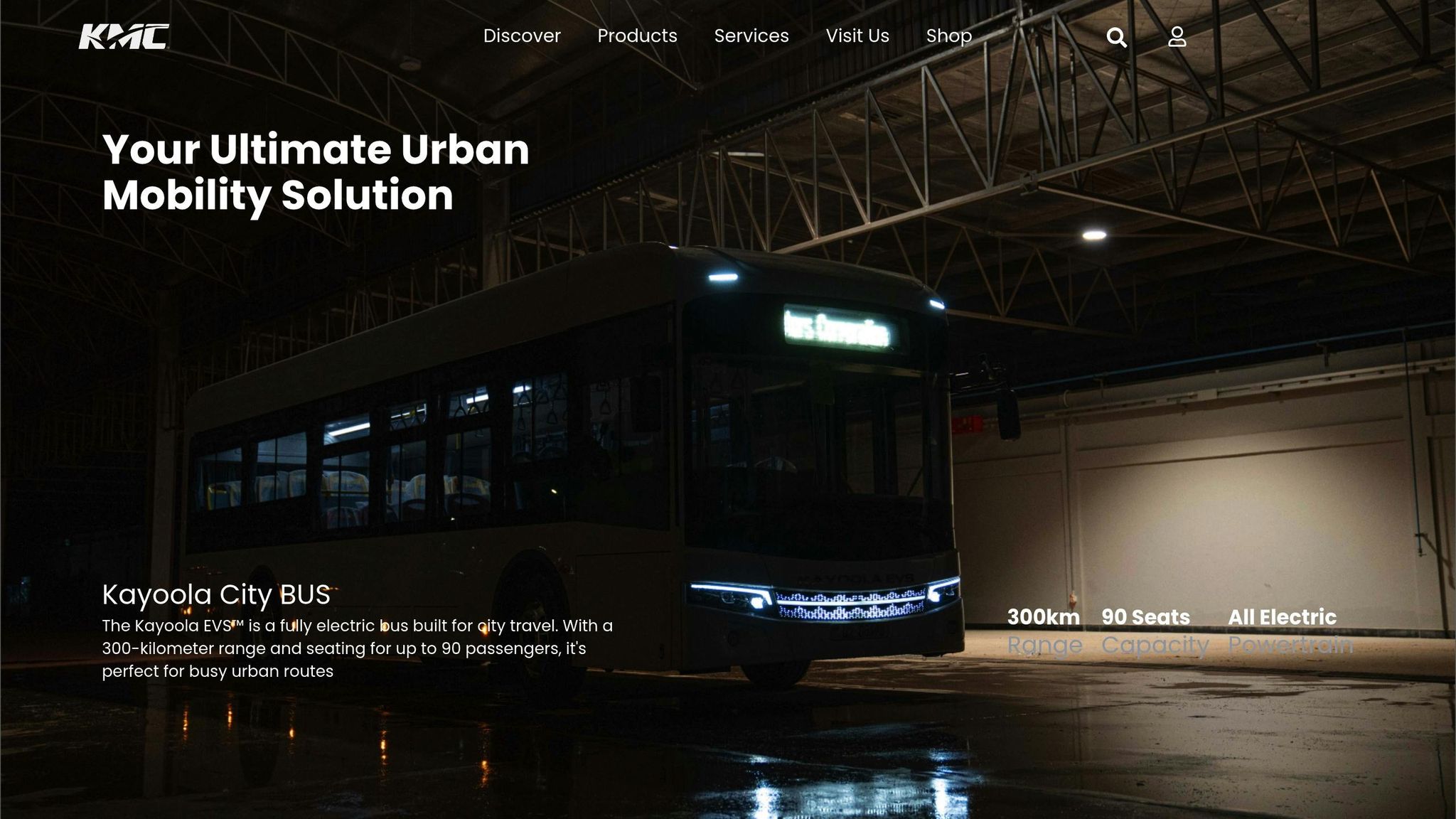Kampala’s traffic and pollution issues are severe, but the Kayoola EVS e-bus offers a practical solution. This locally developed electric bus, designed by Kiira Motors Corporation, promises to reduce congestion and improve air quality in the city. Here’s why it matters:
- Zero emissions: The bus operates without releasing harmful pollutants, addressing Kampala’s air quality crisis.
- Cost-effective: Running costs are $0.19 per kilometer, five times cheaper than diesel buses.
- Passenger-friendly: Features include Wi-Fi, USB charging ports, cashless payments, and a low-floor design for easy access.
- Proven performance: Successfully tested on Kampala’s busy streets and long-distance routes.
Ugandan Experience on the electric Kayoola EVS

Kayoola EVS E-Bus Features and Technical Details
The Kayoola EVS e-bus is reshaping urban transportation, offering solutions tailored to Kampala’s commuting needs.
Technical Specifications
Powered by an electric drivetrain, the Kayoola EVS e-bus is built for continuous city operations. It delivers smooth acceleration and operates quietly, enhancing both efficiency and passenger comfort during transit.
Passenger Amenities
This bus prioritizes comfort and convenience for its passengers. It features an onboard infotainment system that provides access to music, videos, and real-time route updates. To keep passengers connected, the bus is equipped with Wi-Fi and USB charging ports, making it ideal for modern commuters.
Safety is a top priority, with CCTV cameras installed to monitor the interior . Additionally, the e-bus incorporates an e-ticketing system and cashless payment options, simplifying the boarding process and reducing reliance on cash transactions . Its low-floor design makes it easily accessible for seniors, children, and passengers with disabilities, ensuring inclusivity in public transportation . These features set the stage for real-world testing by Kampala’s commuters.
Kayoola EVS Model Comparison
Kampala Commuters Test the Kayoola EVS E-Bus
The Kayoola EVS e-bus has been put to the test by Kampala commuters, showcasing its ability to handle the city’s bustling urban environment.
Comfort and Accessibility
From July to September 2020, staff from the Uganda Civil Aviation Authority used the e-bus for airport routes three days a week. These trials demonstrated that the e-bus offered both comfort and accessibility for daily commutes. The positive feedback from this phase encouraged further operational trials, expanding its testing scope.
Performance on Kampala Streets
The e-bus proved its reliability on Kampala’s challenging and varied traffic conditions. In June 2024, a fleet of eight 8-meter e-buses completed a 236-kilometer (147-mile) journey from Luwero to Jinja without any issues. This successful test run highlighted the e-bus’s potential to tackle the city’s transit demands effectively.
Addressing City Transport Challenges
Feedback from the pilot program suggests the Kayoola EVS e-bus could help alleviate some of Kampala’s persistent transport issues. Fred Bamwesigye, Acting Director General of the Civil Aviation Authority, expressed optimism about the impact of the e-bus:
Kayoola will provide solutions to some of the public transport problems they have been experiencing.
sbb-itb-7bab64a
Kayoola EVS Benefits for Environment and Economy
The Kayoola EVS e-bus offers clear advantages for both the environment and the economy.
Pollution Reduction
As a zero-emission vehicle, the Kayoola EVS operates without releasing harmful pollutants, significantly cutting down greenhouse gas emissions and improving urban air quality. Its quiet operation also helps reduce noise pollution in city environments.
"The E-Bus Xpress fleet is made up of Kayoola EVS electric buses, which are designed to operate without emitting any harmful pollutants."
While the environmental benefits are impressive, the e-bus also delivers notable economic savings.
Cost Savings for Operators and Passengers
The Kayoola EVS stands out as a cost-efficient option. Its operational cost is just $0.19 per kilometer (UGX 320), compared to approximately $1.00 per kilometer (UGX 1,670) for diesel buses – making it over five times more economical.
Maintenance costs are also significantly lower, with annual expenses reduced by 46% thanks to the simpler design of its electric drivetrain. Additionally, energy expenses for the e-bus amount to only 20–22% of the fuel costs required for a diesel bus. Overall, its total cost of ownership comes to just 60% of that of a traditional diesel bus.
Kayoola EVS vs Diesel Bus Comparison
The table below highlights key economic and environmental differences between the Kayoola EVS and diesel buses:
| Metric | Kayoola EVS | Diesel Bus |
|---|---|---|
| Cost per kilometer | $0.19 (UGX 320) | $1.00 (UGX 1,670) |
| Annual maintenance | 46% lower | Baseline (100%) |
| Energy costs | 20–22% of diesel equivalent | Baseline (100%) |
| Total cost of ownership | 60% of diesel equivalent | Baseline (100%) |
| Emissions | Zero direct emissions | High pollutant output |
| Energy source | Renewable (Uganda’s 90% hydro power) | Imported fossil fuels |
How Kayoola EVS Could Change Kampala’s Public Transport
The Kayoola EVS e-bus carries the potential to transform Kampala’s public transit system. With its proven track record and economic appeal, this electric bus could significantly improve the city’s transportation network, offering a cleaner and more efficient alternative.
Boosting Local Manufacturing and Job Creation
Producing the Kayoola EVS locally could be a game-changer for Uganda’s manufacturing sector. By establishing a domestic production base, Uganda can create jobs, enhance workforce skills, and reduce its reliance on imported vehicles. Additionally, local manufacturing could tighten supply chains and improve quality control, making the production process more efficient. This approach not only strengthens the country’s economy but also complements the environmental benefits the Kayoola EVS is designed to deliver.
Advancing Uganda’s Electric Vehicle Goals
The Kayoola EVS aligns seamlessly with Uganda’s push for sustainable transportation. By cutting emissions and reducing dependence on traditional fuels, this e-bus supports a cleaner urban environment. Its adoption could also encourage further investment in electric vehicle infrastructure, such as charging stations and modernized transit systems, paving the way for broader acceptance of electric mobility in Uganda.
AutoMag.ug’s Role in Supporting Innovation

AutoMag.ug plays a vital role in showcasing Uganda’s transportation advancements, including the Kayoola EVS. Through detailed reporting and analysis, the platform raises awareness about emerging technologies and their potential benefits. By keeping the public informed, AutoMag.ug builds trust and transparency in Uganda’s automotive market, supporting the growth of electric vehicle adoption and the broader shift toward sustainable transportation solutions.
Conclusion: Electric Buses in Kampala’s Future
The Kayoola EVS e-bus is setting a new standard for public transportation in Kampala. With a range of 186 miles and the ability to carry up to 90 passengers, this all-electric bus directly tackles urban transit challenges while offering a cleaner, greener alternative.
By running on an electric powertrain, it significantly reduces harmful emissions, contributing to a healthier environment. Additionally, its efficient boarding system improves overall operations, making it a practical choice for busy city routes.
"Engineered for efficiency, comfort, and sustainability, this fully electric bus is perfect for city travel."
- Kiira Motors Corporation
The Kayoola EVS combines innovation, efficiency, and environmental responsibility, making it a promising step toward modernizing Kampala’s public transportation system.
FAQs
How does the Kayoola EVS electric bus help improve air quality in Kampala?
The Kayoola EVS electric bus is making a noticeable difference in Kampala by replacing diesel-powered vehicles with zero-emission electric technology. This shift eliminates harmful pollutants like nitrogen oxides and particulate matter – key culprits behind urban air pollution.
By cutting greenhouse gas emissions and improving air quality, the Kayoola EVS contributes to a cleaner environment while playing a role in addressing climate change. Its introduction is a move toward greener, more environmentally conscious urban transportation in Kampala.
What makes the Kayoola EVS e-bus more cost-effective than traditional diesel buses?
The Kayoola EVS e-bus stands out for its impressive cost savings when compared to traditional diesel buses. One major factor is its lower operating costs – electricity is far less expensive than diesel, cutting energy expenses by an estimated 50–80%. On top of that, maintenance costs are kept to a minimum. Why? Electric buses have fewer moving parts, and they rely on regenerative braking, which reduces wear and tear on brake components.
These cost-cutting benefits not only make the Kayoola EVS more economical over the long haul but also enhance efficiency, making it an excellent fit for Kampala’s urban transportation system.
What impact does the Kayoola EVS e-bus have on manufacturing and job creation in Uganda?
The Kayoola EVS e-bus is making waves in Uganda’s local manufacturing scene. With a target to produce up to 10,000 electric vehicles each year by December 2024, this bold initiative is set to generate over 14,000 jobs across manufacturing, technical, and operational fields.
This project is more than just about vehicles – it’s about reducing Uganda’s dependence on imported cars, fueling industrial growth, and creating opportunities for workers of all skill levels. It’s a move that strengthens the economy while paving the way for a more sustainable future in transportation.
Related Blog Posts
- Top 5 Electric Vehicles Gaining Popularity in Uganda
- Electric Cars in Uganda: What’s Available and Where to Buy ⚡️
- Kiira Motors unveils Kayoola electric buses for public transport
- Uganda bans diesel bus imports to boost local manufacturing




